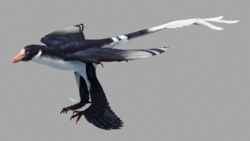Zhongjianosaurus
|
Zhongjianosaurus Temporal range: Early Cretaceous, 125–120 Ma |
|
|---|---|
 |
|
| An artist's reconstruction of Zhongjianosaurus yangi | |
| Scientific classification | |
| Kingdom: | Animalia |
| Phylum: | Chordata |
| Clade: | Dinosauria |
| Order: | Saurischia |
| Suborder: | Theropoda |
| Family: | †Dromaeosauridae |
| Clade: | †Microraptoria |
| Genus: |
†Zhongjianosaurus Xu & Qin, 2017 |
| Type species | |
|
†Zhongjianosaurus yangi Xu & Qin, 2017 |
|
Zhongjianosaurus is a genus of dromaeosaurid belonging to the Microraptoria. Believed to hail from the Yixian Formation, specifically the middle of the Jehol Biota, it is the smallest known microraptorine thus far discovered and one of the smallest non-avian theropod dinosaurs.
Zhongjianosaurus is distinguishable from other microraptorines in the following autapomorphies. Proportionally long ossified uncinate processes are fused to the dorsal ribs. A widely arched furcula is present with slender and posteriorly curved clavicular rami. The humeral proximal end is strongly offset medially from the humeral shaft. The internal tuberosity of the humeral proximal end is short. A large fenestra perforates the humeral deltopectoral crest. The humeral ulnar condyle is hypertrophied. The ulna is slightly longer than the humerus. The ulnar olecranon process has a mediolaterally pinched posterior margin. The ulnar distal end bends anteriorly and is strongly expanded laterally. The proximal end of metacarpal II has a strong ventrolateral extension. Metacarpal III is laterally bowed and adorned with a longitudinal ventral groove. Phalanx II-2 is without a proximodorsal lip and lacks strong dorsal arching. The femoral head is stout and lower than the trochanteric crest. The medial condyle of tibiotarsus distal end has a prominent distal extension. The foot shows the arctometatarsalian condition. Metatarsal II is without ginglymi on its distal end. The authors identify the fingers in the maniraptoran hand as the second, third and fourth, whereas most researchers see them as the first, second and third so that "metacarpal II" would become metacarpal I etc.
The articulated tail has elongate rod-like extensions of the prezygaphophyses and chevrons characteristic of most dromaeosaurids, and these reach almost to the most anterior caudals. The sternum is large, with a maximum anteroposterior length 56% of the femoral length and is long axially in proportion. Bone fusion in the scapula, vertebrae, coracoid, and tarsals suggest that the specimen is a mature adult weighing 0.31 kg (0.68 lb), making it one of the smallest known non-avian theropods thus far discovered.
Zhongjianosaurus was first reported in 2009 when a new species based on a specimen consisting of a partial postcranial articulated skeleton was recovered from the lake deposits in Sihedang, Lingyuan County, in western Liaoning. It was first described by Xu Xing and Qin Zi-Chuan. The genus and specific name honor Yang Zhongjian, China's founder of vertebrate paleontology. The holotype specimen, labelled as IVPP V 22775, is currently housed in the Institute of Vertebrate Paleontology and Paleoanthropology, in Beijing.
...
Wikipedia
